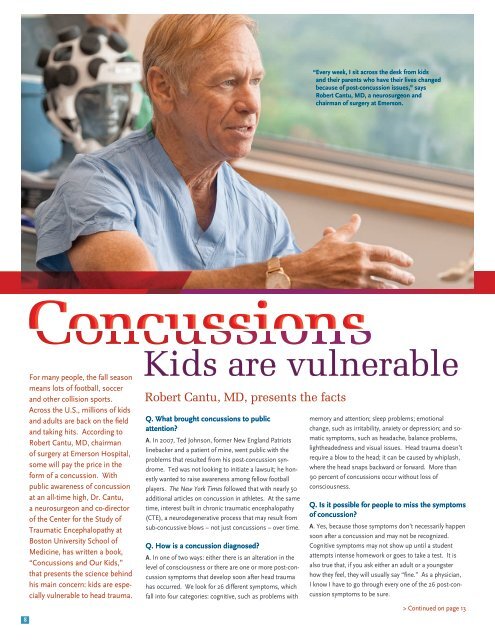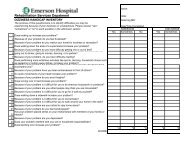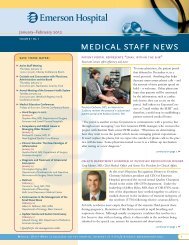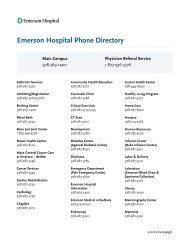Download PDF - Emerson Hospital
Download PDF - Emerson Hospital
Download PDF - Emerson Hospital
- No tags were found...
You also want an ePaper? Increase the reach of your titles
YUMPU automatically turns print PDFs into web optimized ePapers that Google loves.
“Every week, I sit across the desk from kidsand their parents who have their lives changedbecause of post-concussion issues,” saysRobert Cantu, MD, a neurosurgeon andchairman of surgery at <strong>Emerson</strong>.8For many people, the fall seasonmeans lots of football, soccerand other collision sports.Across the U.S., millions of kidsand adults are back on the fieldand taking hits. According toRobert Cantu, MD, chairmanof surgery at <strong>Emerson</strong> <strong>Hospital</strong>,some will pay the price in theform of a concussion. Withpublic awareness of concussionat an all-time high, Dr. Cantu,a neurosurgeon and co-directorof the Center for the Study ofTraumatic Encephalopathy atBoston University School ofMedicine, has written a book,“Concussions and Our Kids,”that presents the science behindhis main concern: kids are especiallyvulnerable to head trauma.Kids are vulnerableRobert Cantu, MD, presents the factsQ. What brought concussions to publicattention?A. In 2007, Ted Johnson, former New England Patriotslinebacker and a patient of mine, went public with theproblems that resulted from his post-concussion syndrome.Ted was not looking to initiate a lawsuit; he honestlywanted to raise awareness among fellow footballplayers. The New York Times followed that with nearly 50additional articles on concussion in athletes. At the sametime, interest built in chronic traumatic encephalopathy(CTE), a neurodegenerative process that may result fromsub-concussive blows – not just concussions – over time.Q. How is a concussion diagnosed?A. In one of two ways: either there is an alteration in thelevel of consciousness or there are one or more post-concussionsymptoms that develop soon after head traumahas occurred. We look for 26 different symptoms, whichfall into four categories: cognitive, such as problems withmemory and attention; sleep problems; emotionalchange, such as irritability, anxiety or depression; and somaticsymptoms, such as headache, balance problems,lightheadedness and visual issues. Head trauma doesn’trequire a blow to the head; it can be caused by whiplash,where the head snaps backward or forward. More than90 percent of concussions occur without loss ofconsciousness.Q. Is it possible for people to miss the symptomsof concussion?A. Yes, because those symptoms don’t necessarily happensoon after a concussion and may not be recognized.Cognitive symptoms may not show up until a studentattempts intense homework or goes to take a test. It isalso true that, if you ask either an adult or a youngsterhow they feel, they will usually say “fine.” As a physician,I know I have to go through every one of the 26 post-concussionsymptoms to be sure.> Continued on page 13
















